Study on the Effect of Natural Aging and PAV Aging on Asphalt Binder Based on Rheology and Microstructural Composition
Abstract
1. Introduction
2. Materials and Methods
2.1. Materials
2.2. Test Methods
2.2.1. Laboratory-Simulated Aging Methods
2.2.2. Natural Aging Methods
2.2.3. Test Methods for Low-Temperature Performance
2.2.4. Test Methods for Chemical Structure
- Chemical structure analysis
- 2.
- Elemental Content Analysis
- 3.
- Average Molecular Weight Analysis
3. Results and Discussion
3.1. The Influence of Different Aging Styles on the Low-Temperature Performance of Asphalt Binder
3.2. The Influence of Different Aging Styles on the Chemical Structure of Asphalt
3.2.1. Chemical Structure Analysis
3.2.2. Elemental Content Analysis
3.2.3. Molecular Weight Analysis
3.3. Correlation Analysis of Macroscopic and Microscopic Performance of Asphalt Binder Under Different Aging Styles
4. Conclusions
Author Contributions
Funding
Institutional Review Board Statement
Informed Consent Statement
Data Availability Statement
Acknowledgments
Conflicts of Interest
References
- Guo, M.; Yin, X.; Liang, M.; Du, X. Study on effect of thermal, oxidative and ultraviolet coupled aging on rheological properties of asphalt binder and their contribution rates. Int. J. Pavement Eng. 2023, 24, 2239426. [Google Scholar] [CrossRef]
- Fu, C.; Wang, Z.; Song, S.; Yao, X.; Wang, F.; Wei, L.; Guo, M. Experimental Study on Anti-Aging Effect of Asphalt Binder Liquid Anti-Aging Agent. Buildings 2024, 14, 1023. [Google Scholar] [CrossRef]
- Pei, Z.; Xu, M.; Cao, J.; Feng, D.; Hu, W.; Ren, J.; Jing, R.; Yi, J. Analysis of the microcharacteristics of different kinds of asphalt based on different aging conditions. Mater. Struct. 2022, 55, 250. [Google Scholar] [CrossRef]
- Zhang, K.; Shen, S. Development and Validation of the Coupled Diffusion-Kinetics Aging Model to Analyze Field Aging Gradient in Asphalt Pavements. J. Mater. Civ. Eng. 2022, 34, 04022194. [Google Scholar] [CrossRef]
- He, Y.; Hu, Q.; Zhao, X.; Zhang, J.; Lyu, L.; Li, Y.; Aldagari, S.; Fini, E.H. Impacts of ultraviolet irradiation on asphalt binder: A comprehensive review. Int. J. Pavement Eng. 2025, 26, 2472839. [Google Scholar] [CrossRef]
- Yuan, J.; Li, H.; Li, T.; Huang, J.; Sun, W. Evolution of asphalt performance under the coupled aging of ultraviolet, high temperature and water. Case Stud. Constr. Mater. 2024, 20, e03220. [Google Scholar] [CrossRef]
- Guan, M.; Guo, M.; Tan, Y.; Du, X. Study on the effect of aging on cracking resistance of virgin asphalt binder and its evolution model. Constr. Build. Mater. 2023, 407, 133443. [Google Scholar] [CrossRef]
- Li, Q.; Zeng, X.; Wang, J.; Luo, S.; Meng, Y.; Gao, L.; Wang, X. Aging performance of high viscosity modified asphalt under complex heat-light-water coupled conditions. Constr. Build. Mater. 2022, 325, 126314. [Google Scholar] [CrossRef]
- Guan, M.; Guo, M.; Liu, X.; Du, X.; Tan, Y. Effect of Multifactor Coupling Aging on Rheological Properties of Asphalt Binders and Correlations between Various Rheological Indexes. J. Mater. Civ. Eng. 2024, 36. [Google Scholar] [CrossRef]
- Traxler, R.N. Relation between asphalt composition and hardening by volatilization and oxidation. Assoc. Asph. Paving Technol. Proc. 1961, 30, 359–377. [Google Scholar]
- Liu, H.; Zhang, Z.; Tian, Z.; Lu, C. Exploration for UV Aging Characteristics of Asphalt Binders based on Response Surface Methodology: Insights from the UV Aging Influencing Factors and Their Interactions. Constr. Build. Mater. 2022, 347, 128460. [Google Scholar] [CrossRef]
- Zhao, Y.; Wu, X.; Chao, Y.; Liang, N.; Zhou, P.; Li, Z.; Mei, Y. Aging characteristics and microscopic mechanisms of SBS asphalt based on coupled light-heat-water aging. Constr. Build. Mater. 2024, 456, 139190. [Google Scholar] [CrossRef]
- Hu, C.; Zhou, Z.; Luo, Y.; Yan, X. Effect of Acid Rain on Mechanical Properties and Aging Mechanism of Asphalt. J. Mater. Civ. Eng. 2023, 35. [Google Scholar] [CrossRef]
- Xing, C.; Zhu, B.; Chiang, K.C.K.; Chen, C.; Liu, L.; Chang, Z. Effect of Salt Solution Environment on the Aging of Styrene-Butadiene-Styrene (SBS)-Modified Asphalt. Polymers 2024, 16, 1709. [Google Scholar] [CrossRef]
- Xu, S.; Cai, S.; Huang, R.; Xu, K.; Ma, Z.; Fang, L.; Zhang, C. Investigation of aging behaviors of asphalt under the coupling conditions of salt and water. Fuel 2024, 365, 131191. [Google Scholar] [CrossRef]
- Porto, M.; Caputo, P.; Loise, V.; Eskandarsefat, S.; Teltayev, B.; Oliviero Rossi, C. Bitumen and Bitumen Modification: A Review on Latest Advances. Appl. Sci. 2019, 9, 742. [Google Scholar] [CrossRef]
- Wu, M.; Yin, L.; Li, M.; You, Z.; Jin, D.; Xin, K. A state-of-the-art review of asphalt aging behavior at macro, micro, and molecular scales. Constr. Build. Mater. 2025, 460, 139738. [Google Scholar] [CrossRef]
- Siddiqui, M.N.; Ali, M.F. Investigation of chemical transformations by NMR and GPC during the laboratory aging of Arabian asphalt. Fuel 1999, 78, 1407–1416. [Google Scholar] [CrossRef]
- Ahmad, M.; Khedmati, M.; Mensching, D.; Hofko, B.; Haghshenas, H.F. Aging characterization of asphalt binders through multi-aspect analyses: A critical review. Fuel 2024, 376, 132679. [Google Scholar] [CrossRef]
- Zhang, S.; Hong, H.; Zhang, H.; Chen, Z. Investigation of anti-aging mechanism of multi-dimensional nanomaterials modified asphalt by FTIR, NMR and GPC. Constr. Build. Mater. 2021, 305, 124809. [Google Scholar] [CrossRef]
- Di, H.; Zhang, H.; Yang, E.; Ding, H.; Liu, H.; Huang, B.; Qiu, Y. Usage of Nano-TiO2 or Nano-ZnO in Asphalt to Resist Aging by NMR Spectroscopy and Rheology Technology. J. Mater. Civ. Eng. 2023, 35. [Google Scholar] [CrossRef]
- Khavandi Khiavi, A.; Ghanbari, A.; Ahmadi, E. Evaluation of Poly 2-Hydroxyethyl Methacrylate-Modified Bitumen Aging Using NMR and FTIR Techniques. J. Transp. Eng. Part B-Pavements 2021, 147, 04020087. [Google Scholar] [CrossRef]
- Hu, D.; Gu, X.; Lyu, L.; Wang, G.; Cui, B. Unraveling oxidative aging behavior of asphaltenes using ab initio molecular dynamics and static density functional theory. Constr. Build. Mater. 2022, 318, 126032. [Google Scholar] [CrossRef]
- Liu, S.; Shan, L.; Li, G.; Underwood, B.S.; Qi, C. Molecular-based asphalt oxidation reaction mechanism and aging resistance optimization strategies based on quantum chemistry. Mater. Des. 2022, 223, 111225. [Google Scholar] [CrossRef]
- Wang, C.; Tian, X.; Wang, Y.; Li, G. The aging mechanism of asphalt aromatics based on density functional theory, Frontier Orbitals, IR, SARA, and GPC. J. Mol. Liq. 2024, 396, 124010. [Google Scholar] [CrossRef]
- Zou, Y.; Pang, L.; Xu, S.; Wu, S.; Yuan, M.; Amirkhanian, S.; Xu, H.; Lv, Y.; Gao, X. Investigation of the Rheological Properties and Chemical Structure of Asphalt under Multiple Aging Conditions of Heat, UV and Aqueous Solution. Materials 2022, 15, 5711. [Google Scholar] [CrossRef]
- Zhang, R.; Shi, Q.; Liu, Y.; Ji, J.; Wen, L. Thermal-oxidative aging characteristics and mechanism of castor seeds oil-based bio-asphalt. Constr. Build. Mater. 2024, 417, 135153. [Google Scholar] [CrossRef]
- Zhang, F.; Liu, Y.; Cao, Z.; Liu, Y.; Ren, Y.; Liang, H.; Wang, K.; Zhang, Y.; Wang, J.; Li, X. Enhancement of Anti-UV Aging Performance of Asphalt Modified by UV-531/Pigment Violet Composite Light Stabilizers. Processes 2024, 12, 2758. [Google Scholar] [CrossRef]
- Wang, T.; Chen, Z.; Wang, Y.; Cui, Y.; Sun, Y.; Ning, R.; Tian, Y.; Zhang, Y. The Effect of Aging on the Molecular Distribution of Crumb Rubber Modified Asphalt Based on the Gel Permeation Chromatography Test. Buildings 2023, 13, 1165. [Google Scholar] [CrossRef]
- Zhang, D.; Zheng, Y.; Yuan, G.; Guo, H.; Zhou, Q.; Qian, G.; Liang, B. Comparative analysis of rheological and microscopic performance of SBS modified asphalt based on field aging and laboratory aging. Fuel 2023, 352, 128933. [Google Scholar] [CrossRef]
- Khalighi, S.; Ma, L.; Varveri, A. Accelerated laboratory simulation of field aging for paving binders using hydrogen peroxide and UV light. Constr. Build. Mater. 2025, 476, 141272. [Google Scholar] [CrossRef]
- JTG E20-2011; Standard Test Methods of Bitumen and Bituminous Mixtures for Highway Engineering. Ministry of Transport of the People’s Republic of China: Beijing, China, 2011.
- Hajj, R.; Filonzi, A.; Rahman, S.; Bhasin, A. Considerations for using the 4 mm Plate Geometry in the Dynamic Shear Rheometer for Low Temperature Evaluation of Asphalt Binders. Transp. Res. Rec. 2019, 2673, 649–659. [Google Scholar] [CrossRef]
- Guo, M.; Zhang, R.; Du, X.; Liu, P. A State-of-the-Art Review on the Functionality of Ultra-Thin Overlays Towards a Future Low Carbon Road Maintenance. Engineering 2024, 32, 82–98. [Google Scholar] [CrossRef]
- Crucho, J.; Picado-Santos, L.; Neves, J.; Capitão, S.; Al-Qadi, I.L. Tecnico accelerated ageing (TEAGE)—A new laboratory approach for bituminous mixture ageing simulation. Int. J. Pavement Eng. 2020, 21, 753–765. [Google Scholar] [CrossRef]
- Yang, B.; Li, H.; Sun, Y.; Zhang, H.; Liu, J.; Yang, J.; Zhang, X. Chemo-rheological, mechanical, morphology evolution and environmental impact of aged asphalt binder coupling thermal oxidation, ultraviolet radiation and water. J. Clean. Prod. 2023, 388, 135866. [Google Scholar] [CrossRef]
- Ren, S.; Liu, X.; Lin, P.; Erkens, S.; Xiao, Y. Chemo-physical characterization and molecular dynamics simulation of long-term aging behaviors of bitumen. Constr. Build. Mater. 2021, 302, 124437. [Google Scholar] [CrossRef]
- Ge, D.; Chen, S.; You, Z.; Yang, X.; Yao, H.; Ye, M.; Yap, Y.K. Correlation of DSR Results and FTIR’s Carbonyl and Sulfoxide Indexes: Effect of Aging Temperature on Asphalt Rheology. J. Mater. Civ. Eng. 2019, 31. [Google Scholar] [CrossRef]
- Asif, S.A.; Ahmad, N.; Asif, S.U.; Usman, S.; Ahmed Zaidi, S.B.; Amin, S. Effect of Aging on Physical, Chemical, and Thermal Properties of Bitumen. J. Transp. Eng. Part B-Pavements 2023, 149. [Google Scholar] [CrossRef]
- Wang, S.; Huang, W.; Kang, A. Evaluation of Aging Characteristics of High-Viscosity Asphalt: Rheological Properties, Rutting Resistance, Temperature Sensitivity, Homogeneity, and Chemical Composition. J. Mater. Civ. Eng. 2021, 33, 04021149. [Google Scholar] [CrossRef]
- Lee, S.-J.; Amirkhanian, S.N.; Putman, B.J. Characterization of Recycled Aged RAP Binders Containing Crumb Rubber Modifier Using Gel Permeation Chromatography. J. Mater. Civ. Eng. 2009, 21, 382–391. [Google Scholar] [CrossRef]
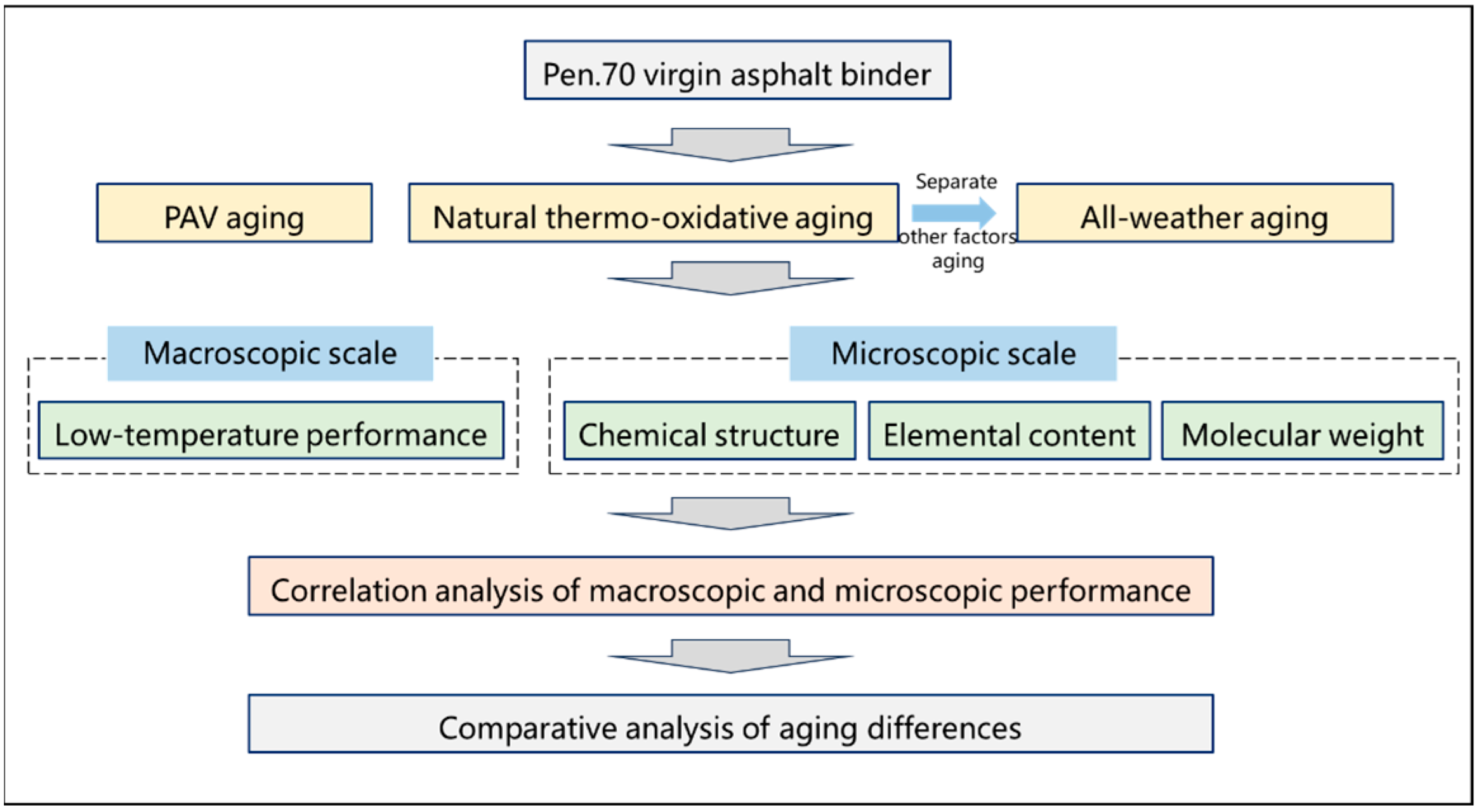
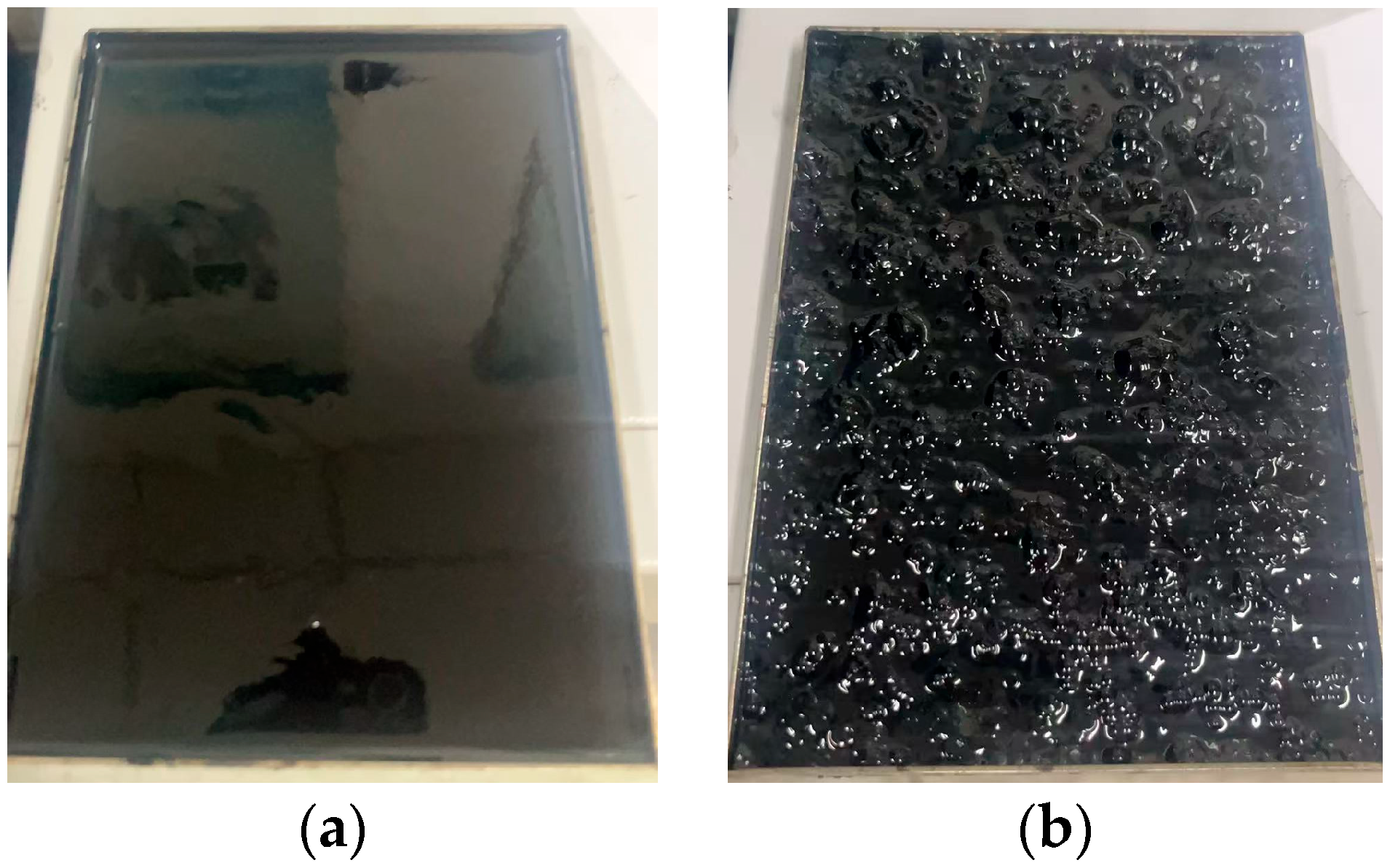
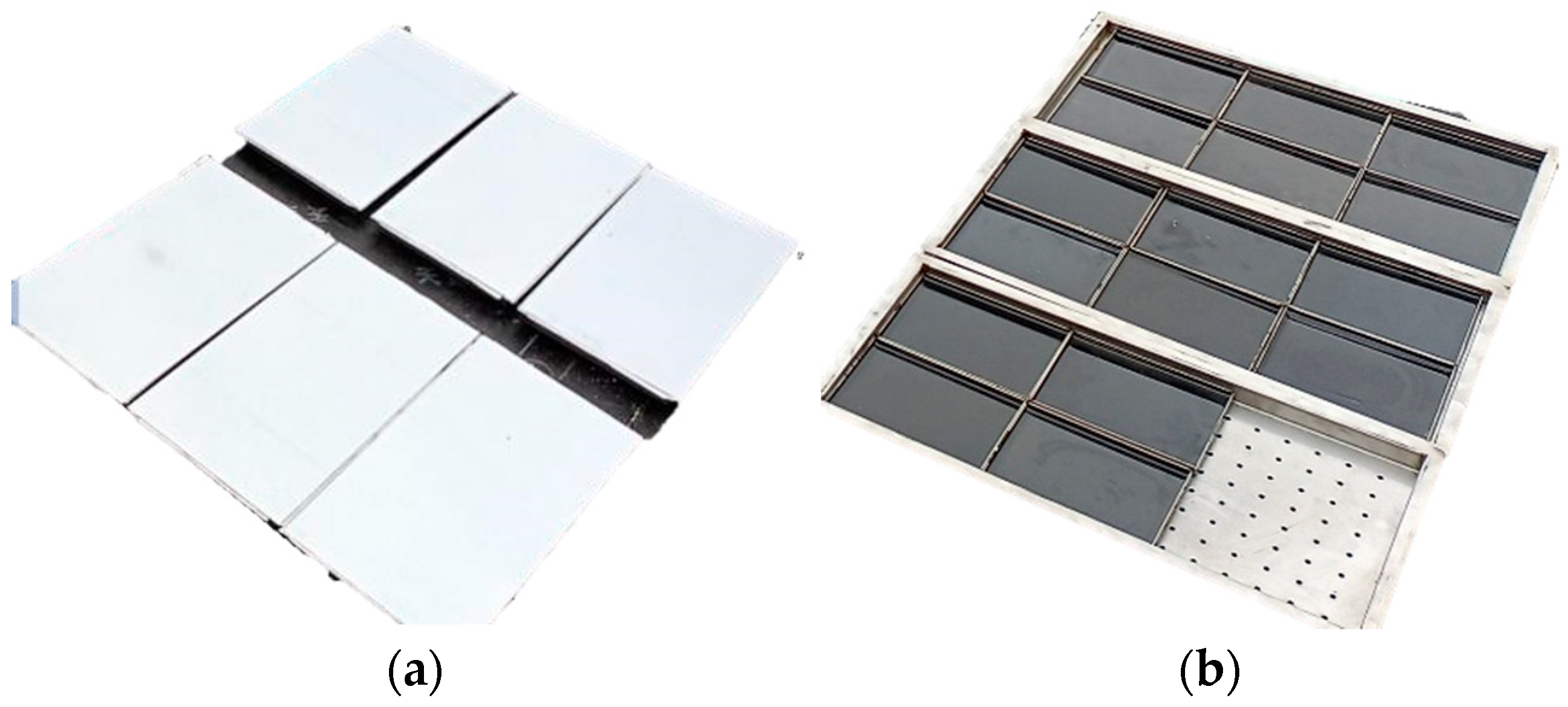
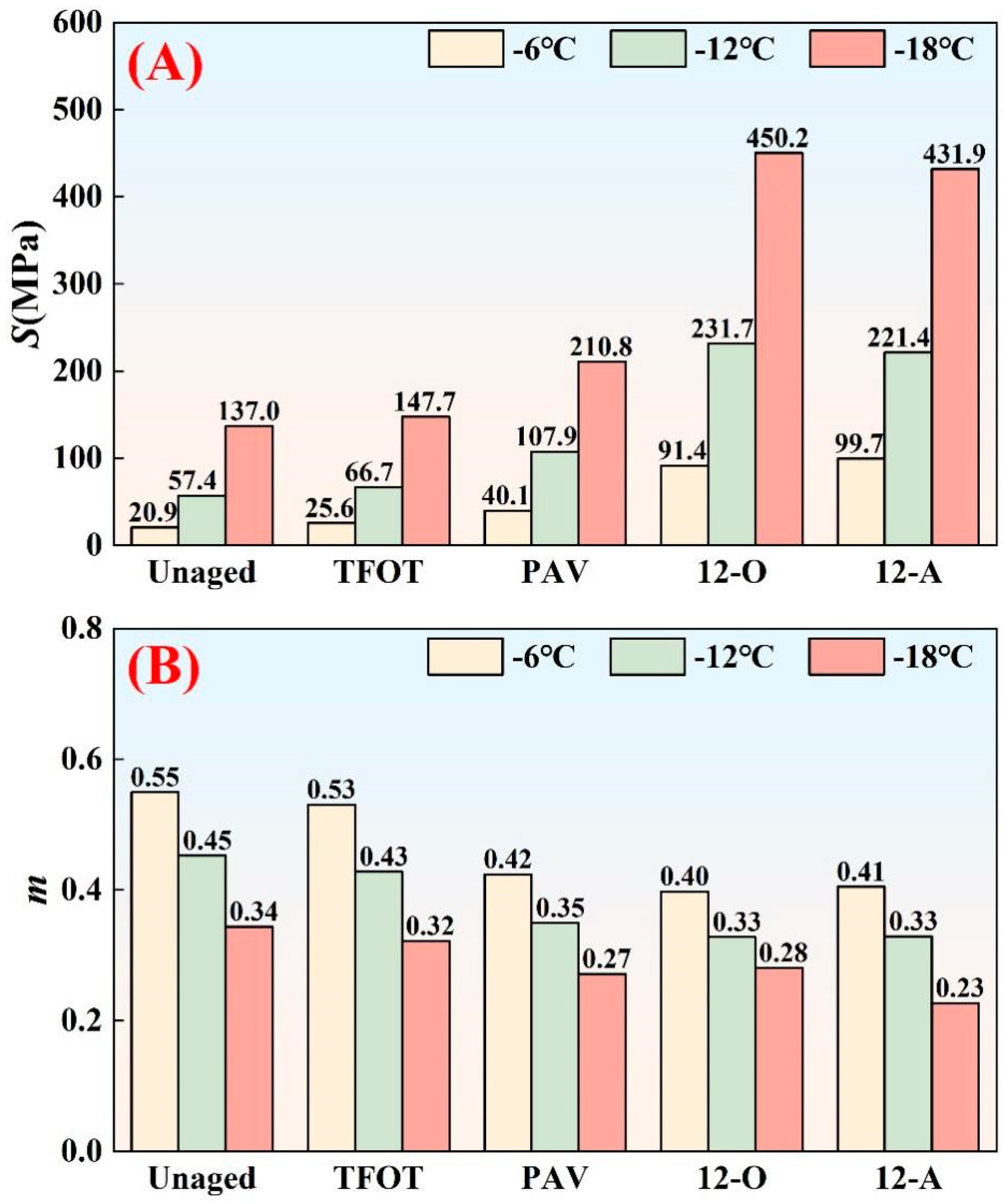
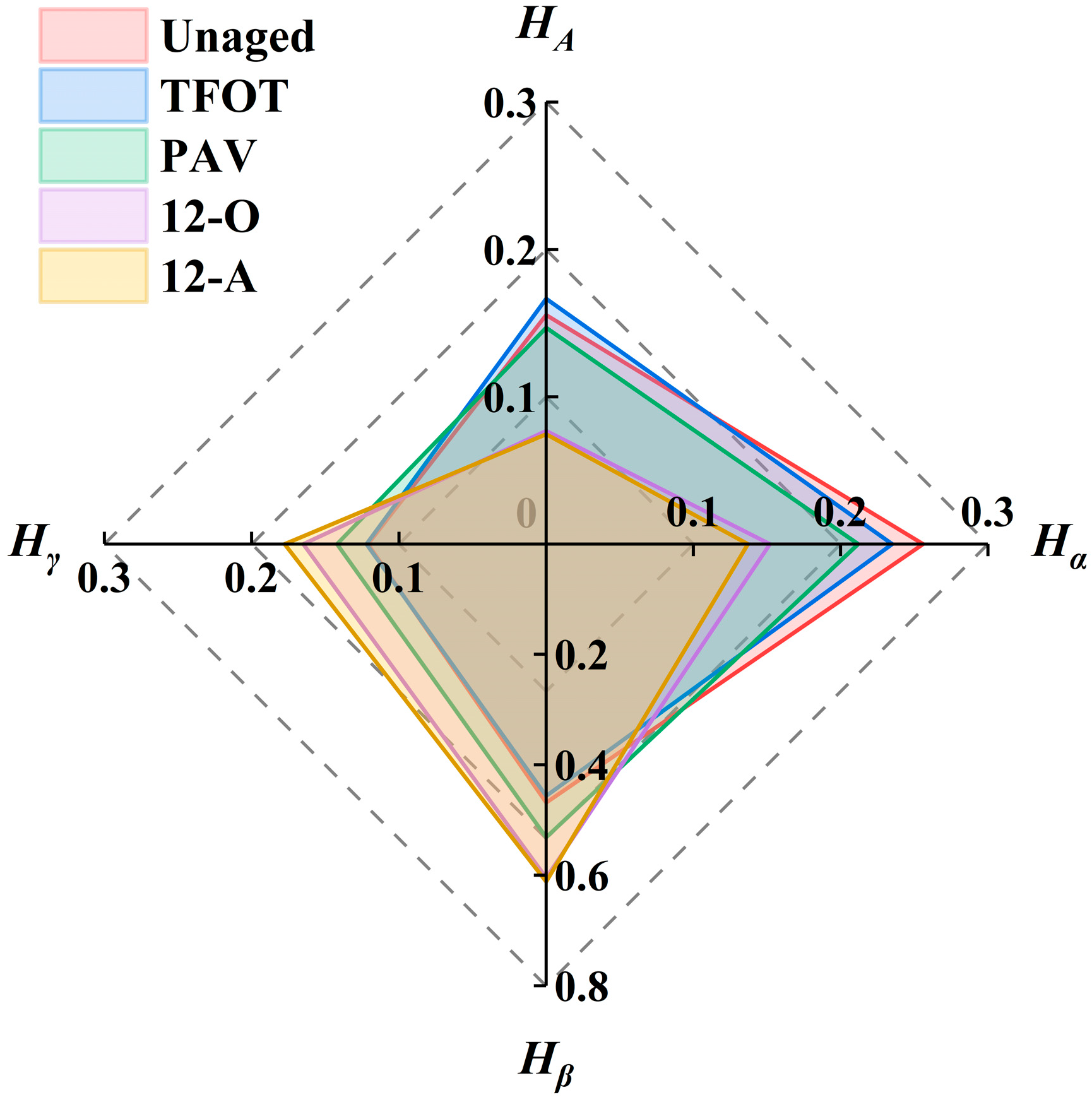



| Tests | Units | Results | Limits | Standards | |
|---|---|---|---|---|---|
| Penetration (25 °C, 100 g, 5 s) | 0.1 mm | 81.5 | 80~100 | T0604-2011 | |
| Softening point (R&B) | °C | 45 | ≥44 | T0606-2011 | |
| Ductility (5 cm/min, 10 °C) | cm | 100 | ≥30 | T0605-2011 | |
| Aging tests (163 °C, 5 h) | The quality change | % | −0.13 | ≤±0.4 | T0610-2011 |
| Penetration ratio | % | 64 | ≥57 | T0604-2011 | |
| Residual ductility ratio | % | 11 | ≥8 | T0605-2011 | |
Disclaimer/Publisher’s Note: The statements, opinions and data contained in all publications are solely those of the individual author(s) and contributor(s) and not of MDPI and/or the editor(s). MDPI and/or the editor(s) disclaim responsibility for any injury to people or property resulting from any ideas, methods, instructions or products referred to in the content. |
© 2025 by the authors. Licensee MDPI, Basel, Switzerland. This article is an open access article distributed under the terms and conditions of the Creative Commons Attribution (CC BY) license (https://creativecommons.org/licenses/by/4.0/).
Share and Cite
Hou, F.; Zhu, Y.; Guo, M.; Zhang, W.; Hailati, B. Study on the Effect of Natural Aging and PAV Aging on Asphalt Binder Based on Rheology and Microstructural Composition. Materials 2025, 18, 5096. https://doi.org/10.3390/ma18225096
Hou F, Zhu Y, Guo M, Zhang W, Hailati B. Study on the Effect of Natural Aging and PAV Aging on Asphalt Binder Based on Rheology and Microstructural Composition. Materials. 2025; 18(22):5096. https://doi.org/10.3390/ma18225096
Chicago/Turabian StyleHou, Fujin, Yunding Zhu, Meng Guo, Wenwu Zhang, and Bolaxiake Hailati. 2025. "Study on the Effect of Natural Aging and PAV Aging on Asphalt Binder Based on Rheology and Microstructural Composition" Materials 18, no. 22: 5096. https://doi.org/10.3390/ma18225096
APA StyleHou, F., Zhu, Y., Guo, M., Zhang, W., & Hailati, B. (2025). Study on the Effect of Natural Aging and PAV Aging on Asphalt Binder Based on Rheology and Microstructural Composition. Materials, 18(22), 5096. https://doi.org/10.3390/ma18225096







